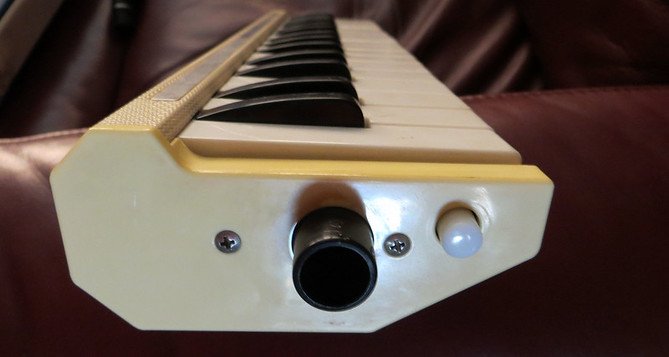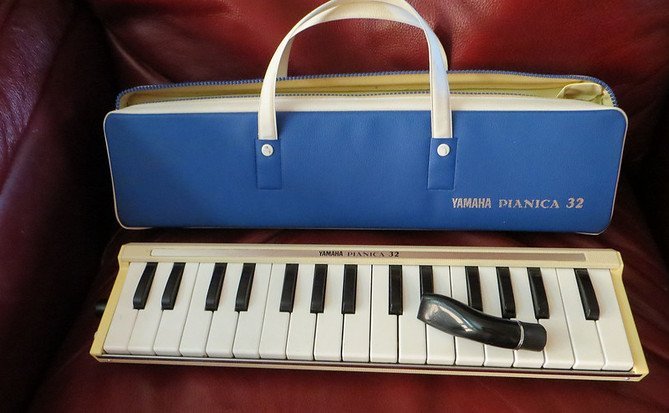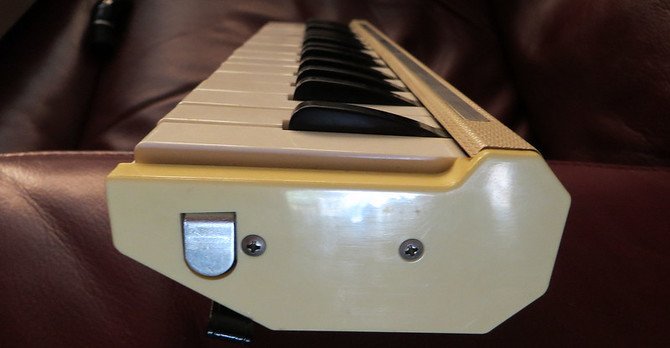Yamaha 32 (vintage)
- This topic has 32 replies, 5 voices, and was last updated 6 years, 4 months ago by
Tyely.
-
AuthorPosts
-
November 18, 2014 at 10:29 pm #3446
 Alan BrintonParticipant
Alan BrintonParticipantThe Yamaha Pianica I’m about to describe appears to be the original first generation ancestor of the current Yamaha P-32D and E. Although I’m uncertain as to the specific year, it is an early 1960s pianica. Its companion instruments are the Yamaha 22 and the Yamaha 34, both of which are listed in our Reviews, with a review of the Yamaha by Carlo. From photos, I am guessing that the Yamaha Pianica 22 was the first and came into production in 1961 or shortly thereafter. My Pianica 32 did not come to me with a tube, but early Pianica 32 photos show it with a tube. It seems unlikely that the first generation Pianica 22 came with a tube. My research suggest that these are the first Yamaha Pianicas and that the first generation models are relatively rare, especially the Pianica 22. The Yamaha Pianica 32 is, therefore, of unusual historical importance among vintage melodicas, and I feel lucky to have obtained one that is playable and in good condition. The most amazing thing about the first generation Pianica 32 is that it sounds almost exactly like the modern day Yamaha P-32D — to my ear, I should say; but I have played the P-32D more than any other melodica. For me, the P-32D set a standard, and I am astonished that the sound standard was actually established over 50 years ago and that the same standard has been maintained since then. There have been other changes, some important improvements, but also some unfortunate compromises. The Yamaha 32 was succeeded by the Yamaha 32A, and then through some series of iterations finally leading to the P-32. Some such process, I’m sure, took place in relation to the Pianica 22 and the P-25D and the Pianica 34 and the P-37D. Melodica Studies graduate students can work out the details.
So here it is, the Yamaha 32:
November 18, 2014 at 11:17 pm #3447 Alan BrintonParticipant
Alan BrintonParticipantSome Notable Features:
1. This pianica is relatively heavy and sits in a metal tray, like the high end Suzukis.
2. The keys are much smaller, i.e. thinner and shorter, than those on the modern day Yamahas. They are narrower though longer than those on the old “piano flute” Hohners from the late 1950s and early 60s. They do not feel as stubby. The keys have a relatively springy feel, and action is even up and down the keyboard.
3. The spit valve arrangement is unique among melodicas I have seen. There is a button at the mouth end that pushes out the little metal plate you see on the other end. This seems like a very solid arrangement. I have not yet disassembled this instrument, but it seems that a solid rod must extend from the button to the cover, and its use creates a feeling of quality and solidity.
4. The mouthpiece is very similar to the modern duck-bill mouthpieces of Yamahas, though the diameter is very slightly smaller.
5. Venting is on the front (past the black keys) of the body of the Yamaha 32, and it is very attractive, in my opinion. Whether it is Bootay friendly, I am not able to immediately determine).
6. While I have not disassembled this instrument, it seems clear that doing so will involve removing the end pieces, and sliding out of the tray.
7. The keyboard of the Yamaha 32 starts at G and ends on D, while the keyboard of the P-32D starts (like all modern day altos) at F and ends on C.
8. The sound is, again, remarkably similar, but I should add that the Pianica 32 is not quite as mellow as that of the P-32D.
9. On the bottom of the Pianica 32 are a 3 inch loop of strap at one end and a strap and a strap fitting on the other, inviting you to devise something (if you feel the need) other than the ridiculous hand straps to be found on most melodicas.
———————–
I have not posted comparison photos partly because my working P-32D is now finished in black, and partly because I have discovered a Japanese blog in which the blogger makes comparisons between the very similar Yamaha 32A and the P-32D. He also examines the insides of the 32A and provides photos. Google will translate for you, as for me, if you’re not fluent in Japanese.http://blogs.yahoo.co.jp/ym5661/folder/387257.html?m=lc&sv=pianica+32&sk=0
Here is his main comparison photo:
November 18, 2014 at 11:28 pm #3450 Alan BrintonParticipant
Alan BrintonParticipantCorrection: I meant to say that early Pianica 34 photos show a tube; I have not seen this in Pianica 32 photos. There is deep interest, I’m supposing, in when tubes first appeared on these instruments, though the tube arrangement appears on much earlier musical instruments and toys, especially in Italy.
November 19, 2014 at 12:00 am #3451 Alan BrintonParticipant
Alan BrintonParticipantOur blogger discusses the Pianica 32A’s tube. So there it is. This guy examines the instrument in an unusual amount of detail. He might be a good source of further information.
December 11, 2014 at 6:25 pm #3546 Alan BrintonParticipant
Alan BrintonParticipantHere are comparative photos of (1) the original Pianica 32 (probably 1961), what I believe is the next generation Yamaha P-32, and the Suzuki A-32, which is an ancestor of the current Suzuki M-32C. The Yamaha P-32(B?) and Suzuki A-32(B?) are both early 1970s models, both with metal tray. I have not yet looked inside these two Yamahas. Notice how much smaller the keys are on the original Pianica 32. But the keys of the blue Yamaha P-32 are also slightly wider than those of the Suzuki A-32. They are almost identical in weight (Suzuki 713 grams, Yamaha 718).
January 5, 2015 at 10:53 pm #3687 Alan BrintonParticipant
Alan BrintonParticipantTOKAI GAKKI Pianica 32
This appears to be identical to the original Yamaha Pianica 32 shown above except for the name and color of the case. The Pianica 32 is quite like the Pianica 25, but some of its features seem to clearly indicate that it is earlier, especially the smaller keys and the circular key springs. I decided to take the Tokai Gakki Pianica 32 apart, since it is not in as good condition and does not play as well as the Yamaha. I bought it for purposes of comparison and in case the Yamaha needed parts. As a point of interest, it formerly resided at the Brooklyn Hebrew Home & Hospital for the Aged.
January 5, 2015 at 11:49 pm #3688 Alan BrintonParticipant
Alan BrintonParticipantDISASSEMBLY AND REASSEMBLY
These first generation Pianicas are solidly constructed, but disassembly is risky, especially if you have not worked on vintage melodicas. This is especially true of the Pianica 32. If it is reasonably well in tune (as they seem to be) and not in need of repair, it’s best to leave well enough alone. The key springs are likely to come off during reassembly and could be easily lost. This pianica was introduced in 1960 or 61, and it is likely to leak air (or more air) after being taken apart, which does not seem to be a problem with later Yamaha and Suzuki melodicas.

The blow end piece does not have to be removed (and is better left on) during disassembly. Whether you leave it on or figure out how to remove it, this feature complicates disassembly/reassembly.


The springs look like the kind of fishing hook that’s called a “circle hook”. They are very easy to remove but difficult to replace. They were not aligned with each other, and it would be almost impossible to get them all parallel during reassembly; but it does not matter. The grooved blue plate has the reeds on the bottom and is the reed air chamber cover. It is screwed on with four large bolts, one of which was missing (which is probably the main reason for leakage). An end screw was also missing.

Here we see the other side of the blue cover after it has been removed, and the inside of the air chamber. The rust colored material is not corrosion; it is some kind of glue or sealant. There is no significant corrosion in this pianica, just a bit on the reed plates.The key pads look uneven, but this is not a problem, since the air hole edge of the cover keeps them aligned.

This instrument has three reed plates, and they are in good shape, despite some of what the British call discolouration.


Here’s the edge of the reed cover lined up with the key pads. During reassembly, the super blue plate/cover is moved up flush with the key pads and slides into the end piece and snaps down into position. During this process, it’s likely that one or more key springs will dislodge, and the keypad mechanisms are at risk if you’re not careful.

Close-up of key pads and of a key. The pads and air chamber gasket are a fairly hard smooth material, as with the Pianica 25, except that these pads have a slight rise that sits in the air hole.


The vents on this Tokai Gakki Pianica 32 are covered inside by a rubbery cloth-like pad. If you try to blow air through them, it can’t be done. My Yamaha Pianica 32 has no such pad, which leads me to suspect that it was added by a resident of the Brooklyn Hebrew Home and Hospital in hopes of muting the sound.January 6, 2015 at 3:33 pm #3701 DarenKeymaster
DarenKeymasterThis is fascinating, thanks Alan.
The small Pianica 32 keyboard reminds me of a Clavietta. Just a small note, could the alignments of the raised sections of the keypads suggest they came about from pressing into the air holes over a long time?
January 6, 2015 at 4:00 pm #3703 Alan BrintonParticipant
Alan BrintonParticipantGood question. I thought not in examining them. But they’ve been sitting there under pressure for over 50 years, and it does make some sense in that it would be unlikely that pre-stamped pads could be aligned so well. I think these pads and gaskets might have some implications for your project, perhaps being printable. If we were seeing some of these features on a new melodica, we might regard them as innovations.
There are strips of a more ordinary kind of gasket material in the Pianica 32 and in the early Pianica 25. They have pretty much rotted away and fallen apart. But they were not there to help seal the air chamber, and don’t appear to have had any functional value. I’d say they are cosmetic, but why that on the inside of a melodica?
March 5, 2015 at 8:37 am #4251 Adam TombsParticipant
Adam TombsParticipantHi there, I have just closed the deal on a vintage Yamaha Pianica 32 that shares design features from all the above posted pics but looks (exactly) like none of the above. I will post pictures if there is any interest?
March 5, 2015 at 4:29 pm #4266 DarenKeymaster
DarenKeymasterYes, do!
March 5, 2015 at 7:12 pm #4289 Alan BrintonParticipant
Alan BrintonParticipantBy all means! The plot is always thickening around here. My guess is that you have the Pianica 32A, but we’ll see. Blue case?
March 6, 2015 at 3:43 am #4291 Adam TombsParticipant
Adam TombsParticipantYep blue case. The ends are more rounded and the vents are doubled. Beige cream in colour. Will post pics when it arrives. ☺
March 6, 2015 at 10:45 am #4296 Adam TombsParticipant
Adam TombsParticipanthttp://i264.photobucket.com/albums/ii179/Chuditch_photo/Mobile%20Uploads/capture_14.jpg
http://i264.photobucket.com/albums/ii179/Chuditch_photo/Mobile%20Uploads/capture_13.jpg
http://i264.photobucket.com/albums/ii179/Chuditch_photo/Mobile%20Uploads/capture_12.jpg
http://i264.photobucket.com/albums/ii179/Chuditch_photo/Mobile%20Uploads/capture_15.jpg
Apologies for the quality. These are screenshots.
March 6, 2015 at 11:02 am #4298 Adam TombsParticipant
Adam TombsParticipantWill be sure to provide better pics when it turns up in the post.
-
AuthorPosts
- You must be logged in to reply to this topic.












